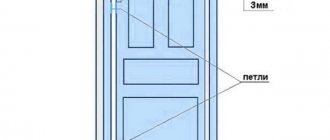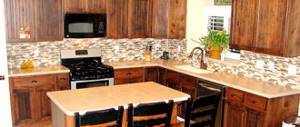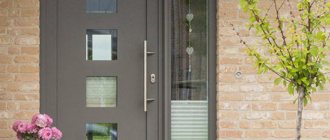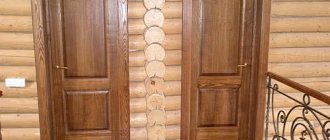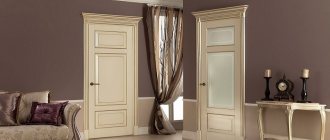Functionality of interior doors and their purpose
The main function of an interior door is to close the passage between rooms.
And depending on the premises being closed, it can have different sizes. For example, the widest structures are installed at the entrance to the hall. The smallest ones are in the office premises. However, such a functional feature as transparency is used only for certain rooms. You can't put them in the toilet or bathroom, that's for sure. Based on purely design criteria, they can be hinged, sliding, folding, or cassette.
There are standards for sizes that were adopted during the construction of the first apartment buildings in Soviet times. They have changed slightly since then. For example, the standard door height is 2 m. Europeans have a standard of 2.1 m. Since most computer programs for the production of various products and building design (meaning purely structural planning and calculation) came to Russia from European countries, then domestic manufacturers gradually switched to this height size. Although you can’t say that about everyone. That is, when choosing a door, you must first measure the height of the doorway.
Size range
Attention! In Europe, they often use modular rather than millimeter measurements. So the height by modular definition will be M21. Everything is simple here: 1 module – 100 mm. It turns out that M21 is 2100 mm.
As for replacing old doors with new ones, if a major alteration is not planned and a simple replacement is being made, then standard standard interior doors are selected. If partitions are constructed or additional openings are made, then the dimensions of the door frame are taken from the major repair project. It is clear that choosing a standard model is not only a simple choice from the products offered by the market, but also simple installation in a standard opening.
Russian standards for interior doors and door frames
An interior door with a frame is called a door block, the parameters of which are regulated by GOST 6629-88, current in the Russian Federation. Block parameters: height, width of the door frame and its thickness depend on their location in the room - living room, kitchen, bathroom, toilet, since the parameters of openings during mass construction were standardized back in the Soviet Union and have been preserved to this day in housing construction projects .
In addition, 80 percent of the housing stock of Russians was built in the USSR according to the mentioned GOST standards and is regularly repaired. So, for example, the width of the opening for the toilet is 71 or 81 cm, for the bathroom 91 and 101 cm, and for the kitchen 121 cm, height 207 cm, openings between living rooms vary from 101 to 191 cm (single and double doors), height 237 cm Most domestic manufacturers are guided by these standards, while a number of foreign ones have similar ones.
It should also be noted the improved quality of products from Russian furniture factories using high-tech equipment. According to GOST, the standard dimensions of interior blocks should be 3 cm smaller than the opening dimensions in height and width. In practice, this gap is significantly smaller and is about 1 cm. The thickness of the door frame depends on the thickness of the walls in the room, which in standard Russian apartments is 7.5 cm.
Therefore, the most common standard box thickness is 7.5 cm, although larger sizes may be available. If the wall is thicker than 7.5 cm, the block is assembled with door panels covering the uncovered wall elements. The extensions are not regulated by GOST and are produced in widths from 8 to 20 cm in increments of 1 cm.
The boxes are made from coniferous wood, mostly from pine, which is less susceptible to warping and deformation, and the canvas is made from a variety of materials: solid hardwood, profiled from PVC, aluminum, using glass. The thickness of the box also depends on the weight of the canvas.
The dimensions of the box are regulated by standards, which recommend using timber no more than 30 mm in width and 80 mm in thickness. However, in practice, large-sized timber is also used. Lightweight interior doors are mounted on timber 50-60 mm thick, heavier ones made of oak or glazed - on timber 7.5-9.4 cm. The box timber in the finished product has a complex configuration, which is also regulated by standards, which allows the use of different materials. thickness dimensions.
Standard sizes of interior doors - GOST and requirements
So, there is a GOST for the sizes of interior doors, according to which they are produced. It indicates not only these parameters, but also the size of the opening for interior doors. These two meanings are interconnected. Table of standard sizes for interior doors:
| Height, mm | Width, mm |
| 2000 | 550 |
| 600 | |
| 700 | |
| 800 | |
| 900 | |
| 1200 – with two leaves, each width 600 mm | |
| 1400 - with two doors, the width of one is 600, the other is 800 mm. | |
| 1500 - with two doors, the width of one is 600 of the other, 900 mm. |
With two doors
If the dimensions of the door you purchase exactly correspond to the parameters indicated in the table, then you are very lucky. Because standard products are much cheaper than ordered ones. Of course, the doorway can be adjusted to fit a custom door, but this is not always possible. This is especially true for panel houses, in which it is impossible to widen the openings or increase their height. This violates the integrity of the entire structure of the house.
There is one more parameter that must be mentioned. This is the width of the timber from which the door frame is made. Essentially, when planning and marking, three dimensional indicators are taken into account:
- the clear opening is the width of the door leaf;
- door frame width;
- width of the opening in the wall.
Installation dimensions
By the way, we can’t talk only about width here. Exactly the same relationship exists between the height parameters. So, between the outer ends of the box and the inner ends of the wall opening there should be a gap of 10÷15 mm. This is done so that the box can easily fit into the opening and so that it can be aligned in planes.
Standard door opening sizes
A table of standard dimensions for the height and width of a doorway in accordance with the same box dimensions that were indicated in the first table:
| Height, mm | Width, mm |
| 2060÷2090 | 630-650 |
| 680-700 | |
| 780-800 | |
| 880-900 | |
| 980-1000 | |
| 1280-1300 | |
| 1480-1500 | |
| 1580-1600 |
As you can see, the standard dimensions of doorways are slightly larger than the door parameters.
Doorway parameters
Door frame dimensions
And one more indicator that must be taken into account is the thickness of the door frame timber; it determines the thickness of the interior door. Standard size is 75 mm. It was legalized for one reason - the thickness of the reinforced concrete slab, which is used for partitions in old-type apartment buildings. It was this thickness that guaranteed the required load-bearing capacity of the non-load-bearing walls.
Standard dimensions of interior openings
The size ranges of Russian GOST 6629-88 and foreign DIN, CEN, ISO are similar. According to domestic, American and European standards, the width of the narrowest blade is 600 mm. Standard sizes of interior doors satisfy the demand of owners of standard housing. The step of the size range is 100-200 mm.
Selection advice: the installation width of the interior door system is 70 mm larger than the actual width of the leaf; this must be taken into account when choosing the size. For openings exceeding this value, we select a structure of the next size.
The height of the interior door is 2000 mm and 2300 mm according to GOST standards; the size range of international regulations includes structures with a height of 2100 mm. The limitation in the choice of these indicators is explained by the limited height of the premises.
Recommendations for measuring the opening and choosing the size:
- the opening is measured along vertical and horizontal lines using a plumb line and level - the opening may be of irregular shape;
- the dimensions of the canvas are determined by the size of the “clean” passage;
- For interior openings with a width of more than 900 mm, it is recommended to order a double-leaf system, since it has less load on the hinges and frame elements.
The thickness of the interior door leaf can range from 20 to 45 mm. The thickness of the doors of sliding systems is about 20 mm, from solid wood - up to 45 mm. When installing a door between thick walls, additional cladding panels are used.
It is not recommended to enlarge openings in bathrooms to install large door leaves. Wide hinged interior structures are inconvenient to use in small rooms, and the partition may not be long enough to install a sliding system.
In addition to models with dimensions that meet regulatory requirements, manufacturers offer services for the production of interior doors according to customer dimensions for openings of complex geometric and curved shapes.
How to correctly measure the opening parameters
This is a very important component of the repair, because this action determines whether the door structure will fit into the opening, and what size the gaps between the mating elements will be. The thing is that the quality of construction in those early years left much to be desired. Therefore, openings in the walls do not guarantee the evenness of the ribs, both vertically and horizontally. That is, the geometry of the shape is not an exact rectangle.
Therefore, measurements must be taken in several places. It's usually around the edges and in the middle (even in multiple places). In this case, all measurements are carried out strictly in planes, that is, horizontally and vertically, for which you will have to use additional control tools such as a plumb line and a laser level. The photo below shows how to correctly measure the dimensions of the opening for an interior door with a frame.
Measuring rules
As practice shows, the doorway very often does not correspond to standard dimensions. If the actual parameters are slightly larger, then this is not a big problem. The gap can be filled with mortar and closed with additional elements, or you can order a door with larger parameters. If the dimensions are smaller than standard, then the edges of the opening will have to be adjusted to fit them. Or adjust the door to the opening.
Attention! If the opening width is more than 1000 mm, and the door is supposed to be hinged, then you will have to order a double-leaf version. Because the door leaf should not be more than 900 mm.
Why such a strict warning? It's all about the weight of the door leaf. Its hinges simply cannot withstand long-term use. After which it will simply begin to sag, and this will cause problems when closing.
Extras
And a few words about the extensions for interior doors, or rather about their sizes. Even here there are standard parameters: length - 2.1 m, width - 0.7÷2.5 cm, thickness 0.6÷3 cm - this is for the strip with which part of the end of the wall is covered. But it must be noted that the width can reach up to 4 cm. This is for load-bearing walls. As for platbands, there are no standards.
Useful tips
- To achieve high accuracy of measurements, they are made at different niche heights. If there are doubts about the correctness of the calculations, you should call a surveyor.
- It may turn out that the door leaf is larger than the permissible size and needs to be cut. This procedure is not suitable for all door panels. In most cases, it is not practical to do it yourself. This work requires professional equipment.
- To install structures that do not require a box and platbands (compartment, rotary, pendulum), strict alignment of the gap around the entire perimeter is required.
- When installing interior and entrance blocks in a new building, the installation gap is made a little larger taking into account shrinkage.
We invite you to familiarize yourself with DIY bathroom cladding with PVC panels
Selection of the sizes of standard interior doors with a frame between the corridor and the hall
Table number one shows the dimensions of wide doors, which are designated as double doors. Above, attention was focused on why structures with two doors are installed in these places. But it must be added that standard interior doors with frames installed in the passage to the hall are the dimensions of typical openings. Even in those distant Soviet times, the passage to the hall was made wide, because the living room is a place where a lot of people sometimes gather. This means that the entrance to this room should be large. In addition, it is in it that large furniture is installed, which may not fit into the opening with small dimensions. That is, they took into account both purely aesthetic criteria and purely practical ones.
Doors to the hall
Double-leaf interior doors
If the room is large, then swinging double-leaf wooden doors will look amazing. For such products, the use of two canvases is provided, made according to the standard and GOST, the dimensions of which depend directly on the version of the door model and opening.
Standard dimensions for one-and-a-half and two-leaf doors (width and height)
According to GOST, the opening width of such door structures is 120-150 cm. Thanks to these dimensions, it becomes possible to install a double door that meets the needs of consumers. If the opening is small, but you want to install a spectacular door, then you can make one leaf smaller. This design is very functional.
A small canvas can be made blind, this is not prohibited by GOST, or with the possibility of opening in rare cases, for example, for bringing a sofa or other large items into the house. The width of such a fabric, according to the GOST standard, is equal to half or a third of a normal product. The second part acts as a full-fledged door leaf. When using two identical sashes, the opening width increases several times, which makes passage easier for a large number of visitors.
One-and-a-half interior door with a blind component
As for single doors, the height standard for this option ranges from 200-210 cm. When the house has large ceilings, to create an impressive visualization, their height is increased by including a special insert. Its installation gives the doors a luxurious appearance and facilitates the operation of the leaves. It is not uncommon for this kind of door products to be found in the mansions of wealthy people.
Marking of interior doors
All wooden door structures are controlled by GOST number 6629-88. This document states that products (wooden) have a graphic and letter designation. We are interested in the letters because they are indicated in the accompanying documents.
So, what do the letters in the markings mean?
- “O” - with glazing;
- "G" - solid design;
- “K” - canvas with a swinging sash;
- “U” is a reinforced model that can be installed as an input.
At the same time, there are letter designations that relate directly to the structure. The letter “D” means that this is a door block, the letter “P” means that it is just a leaf.
Attention! The marking of interior double-leaf doors must indicate the dimensions of the leaves.
Deaf model
Parameters of interior doors
Knowing the parameters of the canvas will make it easier for you to select and install. And you will also be able, guided by the knowledge you have acquired, to correctly take all the necessary measurements and finishing work on the walls in the opening.
The width of the doors of our time
Manufacturers in Russia and Europe have different ideas about some characteristics of canvases and their components. However, such a parameter as width is almost the same for all manufacturers.
Interior door width
Our factories make them in the following range of width dimensions: from 55 centimeters to 90 cm.
You should know! Domestic manufacturers also make “magpies,” but they are usually used when installing double-leaf doors (see Double-leaf door block: design features).
So:
- At 550 millimeters - this is a classic option for toilets and bathrooms in small apartments - Khrushchev-era apartments.
- 600 mm wide are also often used in sanitary facilities. Another use for them is as part of a double door.
- If the width of the interior door is 700 mm , then such an instance will have to “guard” the open spaces of the kitchen.
- Canvases with a width of 800 and 900 mm are most often used in openings between living rooms and children's rooms. They are also installed as a second door after the entrance metal door.
Width of a double interior door
The given door sizes are the most common. But if your taste requires more, you can always order a custom width. But keep in mind that you will have to fork out for this. Sometimes by paying double the standard price.
European doors are not particularly different: the width of their running leaves is also a maximum of 90 centimeters, and a minimum of 60. In this case, doors are made in width increments of 10 centimeters.
All dimensions given were for single swing structures. What are the dimensions of double doors? They range from one meter to 1.4 m.
You should know! A double swing or sliding door can be made from parts of different widths. For example, 600 and 800 mm - 1400 mm double. The same size can be achieved using two identical 700 mm panels.
The opening method (see What types of interior doors are there) determines the required opening width. Therefore, before preparing it, it is worth deciding how your door will fulfill its direct responsibilities. That is, it will move and move apart or swing open and pretend.
Height
About 30 years ago, all doors in our country had two standard heights - 1.9 and 2.0 meters. Today, thanks to the variety of architectural structures of houses and apartments, other common sizes have appeared - 2.1 and 2.3 meters.
Doors to the ceiling, which are also called sliding partitions, are also gaining popularity. Their feature is the large weight of the structure - up to 130 kilograms!
In foreign countries, they mainly produce doors with a height of 210 cm. Their leaves are designated with the M21 marker. This means that the height is 2 meters and 10 centimeters.
Is door thickness important?
Thickness is an important characteristic.
It affects directly or indirectly the following indicators:
- noise suppression;
- strength;
- appearance.
The thickness does not directly affect the sound insulation properties, since the main role for this indicator is played by the material of manufacture. But with the same interior door design, a thicker door will suppress noise better.
Interior door with rebate, thickness
The thicker the door, the stronger it is. There is a direct relationship here. Although the composition of the filling is also important: solid wood, honeycomb core, glass or panel. The most common sizes of modern doors in thickness are from 35 to 40 millimeters.
In general, this parameter of the canvas has large variations:
- Hinged sliding doors can have a thickness of 20 mm or more.
- In addition to the standard 35 and 40 mm, they can be 36 mm and 38 mm thick.
- The thickness of the door on which the “quarter” array is sampled can be 40, 44 or 45 millimeters.
- The canvases, which are made from pure wood, have a thickness of 40 mm. A thicker model can also be made to order. For example, 50 millimeters.
Standard GOST sizes
Dimensions of non-standard interior doors
What does it mean to have non-standard interior doors and what are their sizes? That is, if a door with, say, a width of 700 mm does not fit into the opening, and a door with a width of 600 mm leaves large gaps, then it is necessary to make a structure with parameters somewhere between these values? Will this be a non-standard model?
If “YES”, then all products made to order and not falling within the parameters of GOST can be considered non-standard. But let's think sensibly. The construction of apartment buildings is carried out according to projects that are themselves developed according to standards. This means that they cannot have non-standard doorways.
Non-standard tricuspid
Then under what circumstances are non-standard designs used? Option two:
- When redevelopment of an apartment is carried out, where a partition is being built. You can install a non-standard model in it.
- When a private house is being built, in which it is possible not to use standards for the size of doorways.
What are the standard sizes of doorways
GOST 6629-88 establishes the following standard dimensions of doorways:
- Heights - 2100 mm or 2400 mm;
- Widths – 710 mm, 810 mm, 910 mm, 1010 mm, 1210 mm.
For example, according to GOST, a door leaf 800x2000 mm assembled with a door frame should have an installation size of 870x2071 mm, and the doorway for this door should be made with dimensions of 910x2100 mm.
Attention! As can be seen from the above, if you make a doorway in accordance with GOST, and purchase a door, as in the previous example, with a door block size of 850x2055 mm, you will encounter problems during its installation: such an opening is too large for this door block to be securely fastened in it.
Scheme of door and door frame measurements
Here it is necessary to take into account that GOST was compiled at a time when polyurethane foam was not used when installing doors, and is designed for installing doors using the “wet method”, when the gaps between the wall and the door frame were filled with plaster. In itself, this method has completely discredited itself - I still remember the consequences of such an installation, when in a completely new apartment not a single interior door was closed normally from the first days: under the influence of moisture from the plaster, the wooden door frames twisted even before the start of operation.
Advice. Doorways must be made 20mm smaller in width and 30mm smaller in height than GOST recommends.
If, after creating an opening for installing doors, you plan to screed and lay floors, the height of the opening must be increased by an amount equal to the height to which the floor level will subsequently rise.
Variety of interior doors
Basically, all interior doors are divided into three categories, which are based on purely constructive solutions.
- Swinging, when the canvas opens by twisting around hinges.
- Sliding, when the canvas moves along the wall along guides.
- Folding, when the structure folds like a book, opening a passage.
Swing
The most commonly used type. People’s conservatism sometimes reaches the point where swing models are installed even where they don’t belong.
| pros | Minuses |
| Simplicity of design | Opening requires a certain amount of space. In narrow spaces this can cause some inconvenience. |
| Easy to install | |
| A good degree of sealing of the gaps between the frame and the canvas, which ensures noise and heat insulation of the room |
Sliding
These models are often called sliding doors. There are two varieties here, which differ from each other in the openness of the canvas when opened. That is, it simply moves along guides along the wall or is recessed into the wall itself. The second option is preferable, but it is difficult to install.
The disadvantages include the fact that special fittings are required for installation. And the installation process itself is not easy. Like swing doors, they can be single- or double-field. In the second case, the doors simply move apart in different directions when they need to be opened.
Folding
By the way, the first two options can be designated as the standard size of interior doors with a frame. What can not be said about the folding design. This is the most convenient way to cover non-standard openings. The canvases in them are fastened together with hinges, and movement is carried out on rollers. In this case, the number of sashes can be unlimited. Everything again will depend on the width of the opening.
It should be noted that the minimum width of one leaf is 10 cm. That is, the smaller this indicator, the more sashes will have to be made for the structure. Although such models look very original.
The advantages include the ability to close curved openings. But there is one single drawback that is quite serious. This is a loose connection of the canvases both with each other and with the box. So no tightness.
Related article:
Folding interior door book. A separate material presents photo examples of successful designs, advice on selection and installation.
This concludes our review. If you have any questions or comments, please leave a comment, we will be happy to answer them.
And finally, a short educational video on today’s topic:
Standard sizes according to GOST
When measurements are taken of the internal space of an opening, according to GOST, several dimensions are taken into account at once. The height, width of the opening, its thickness, as well as the weight of the future structure are taken into account. The dimensions of the hole in the wall will be larger than the parameters of the finished door, since the entire interior structure along with the door frame fits into it. If, nevertheless, the internal dimensions turn out to be larger than the product already purchased, then to make the final alignment of the walls, use a brick, but do not forget about the weight of the product. Before installing the box, thoroughly prepare the wall surface and remove all loose elements.
Measurement of the internal space of the wall in width
One of the main and, as a rule, the first structural elements to be installed is the box. According to GOST, the box has the same internal dimensions as the canvas itself, but they will be wider in width by exactly the thickness of the gap. If the box is not provided with a technological gap, the door will be difficult to open and close. In some cases, the width of the planks alone is not enough, therefore, according to GOST, in order to increase the free space, extensions are used.
Basic elements of canvas installation
The door itself is installed next after the frame. It becomes the highlight of the new design. A door and frame made in accordance with GOST will bring unique decorated elements into the room. Since sizes vary in different directions, let's consider the main parameters that affect them:
- The width of the door is the first and most important size. According to GOST, the standard door leaf for interior design has a width of 70 and 80 cm. In small apartments, in order to save free space, doors with a leaf width of 60 cm are often made, but they are mainly installed in the bathroom or toilet. For entrance doors, the width according to GOST is 90 and 100 cm, so that it is possible to carry large-sized furniture or equipment into the opening;
- product height. Since most of the apartments were built back in the Soviet Union, the dimensions of the doorways in them remained standard, and vary from 190 to 210 cm. The average according to GOST is the height of the canvas equal to 200 cm. Here it is important not to forget about the future floor covering and, accordingly , leave the necessary gap for this. Otherwise, the door will cling to the floor;
- door leaf thickness. This is a minor parameter, since it is rarely taken into account when choosing a specific door model. Thickness affects the sound insulation and weight of the structure. This indicator, like the width, is reflected in GOST.
Dimensions for single interior doors (height and width)
Who observes the standard sizes of interior doors with frames?
A ready-made door kit costs 30–50% less than custom-made products. However, such doors are not regulated in size. For example, a kitchen model may not fit into the opening.
If you have a standard apartment, choose doors with Russian-made frames: they are made to the standard dimensions of doorways specified in construction GOSTs and SNiPs. The products fit the openings of Khrushchev and block houses, as well as most new buildings. The dimensions of European doors, as a rule, exceed Russian standards - you will have to increase the openings, spend time and money on construction work and subsequent wall finishing.
Handicraft workshops do not have the capacity for in-line production of standard products and quality control, so deviations from standard dimensions can be significant. It is better to buy door kits from large factories.
